Inca Trails: Journey Through the Bolivian and Peruvian Andes
Photos by Martin Li and an extract from his book
 |
| Morenada dancers, Island of the Sun, Lake Titicaca. |
Rounding a corner on a wooded headland, I was immediately engulfed by the overwhelming solitude so characteristic of Lake Titicaca. The thin air was still, the surface of the great lake unruffled. Not a sound interrupted the silence. The intensely blue, icy lake, surrounded by glorious vistas rimmed by snow-crowned peaks, is sacred to many cultures, and was the cradle of Andean civilization. According to legend, the first Incas Manco Capac and Mama Ocllo rose from its mysterious depths to begin their ministry to bring civilization to a chaotic world.
The beautiful and tranquil Island of the Sun is rife with Andean mythology and littered with Inca ruins. As I gazed over the Island of the Moon, over which a full moon had fittingly risen into a dark sky smeared with stars, the lunar reflection rippled across the calm surface, joining the Islands of the Sun and Moon in a shimmering bridge of light. Occasional flashes of lightning danced over the distant peaks of the Bolivian Andes. Even knowing nothing about Lake Titicaca’s history and mythology, this was intensely moving. With the Inca legends added in, the experience verged on the spiritual.
 |
| Totora reed boat on Lake Titicaca. |
Our objective was to trace the rise and fall of the Inca empire by way of a journey from its Lake Titicaca birthplace, through the imperial heartland to its capital of Cuzco, and beyond through the Sacred Valley to the densely forested Cordillera Vilcabamba, where the Incas made their final stand against the Spanish Conquistadores.
From the lake, we traveled north across the treeless, pale green Altiplano. The snow-capped Cordillera Real sparkled on our horizon. Small settlements and remote farmhouses were scattered across bleak rolling plains interspersed by low, isolated hills. Occasional campesinos worked diminutive fields, their small herds of llamas and alpacas grazing on thin pickings.
Beyond Sorata, we shadowed the Camino del Oro, an ancient Andean gold mining route. Crossing several chilly mountain passes, we reached Mount Paititi, which many have searched in vain for a legendary Inca city believed to lie hidden beneath impenetrable cloud forest swarming with bears, pumas and snakes with two heads!
Reaching Amarete, distinctive Inca terraces suddenly carpeted all visible mountainside from high peak to river. Mile upon unbroken mile of valley-filling terracing contoured beautifully all the way to Curva. Peru currently dominates the publicity for Inca terracing, but this Bolivian valley surely boasts the most impressive terracing anywhere. Even after 500 years, these stepped fields still yield abundant maize, peas, potatoes and wheat for local communities.
Curva is the home of the Kallawayas, the ancient healers and fortune-tellers of Bolivia’s Apolobamba mountains, who once treated Inca aristocracy. We climbed towards Akhamani, the Kallawayas’ most sacred peak, and hand-caught trout from a tiny stream which we devoured for supper in the dark, cozy, smoke-filled interior of a Quechua house. We scrambled steeply over dark rocks to a succession of rarefied passes, where we placed white stones on summit cairns for good luck and strength. Our requests were answered almost immediately as condors soared magnificently over our heads.
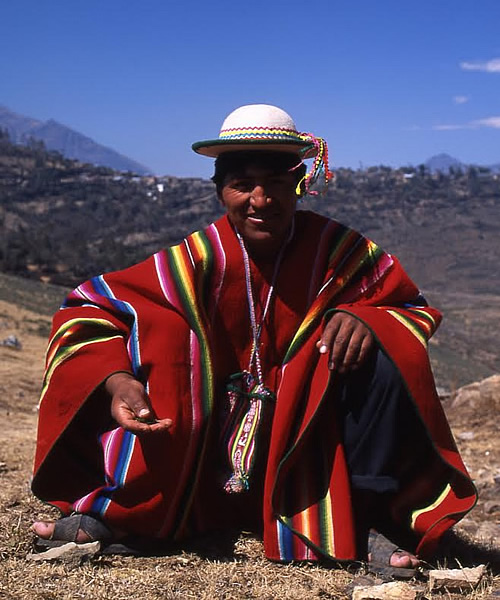 |
| Kallawaya healer and fortune-teller. |
The following dawn, we struggled out of iced up tents into a bitterly cold morning and the sight of Akhamani bathed in brilliant sunshine against a cloudless blue sky and nearly full moon.
From the 5,100m Sunchulli Pass, the snow-covered Apolobamba peaks stretched into the distance to our left. To our right, the Sunchulli glacier towered above the calm turquoise Laguna Verde, beyond which scowled a dark, brooding ridge protected at its base by impossibly steep scree.
Tired and damp, we staggered into the misty stone town of Pelechuco on festival day, which locals celebrate with bullfights in the main square. We paused briefly to watch the alcohol-fueled festivities before continuing northwards. Reaching the summit of the Katantika Pass rewarded us with some of the finest scenery in the Andes: glaciers and crevasses glinting in the sun plunged towards the valley far below, rimming a tranquil, trout-filled lake bordered by Inca paving. And another condor perched not far above my head. Beyond the pass, the landscape mellowed markedly from jagged, icy summits to endless rolling pampas, and eventually Peru.
For several days, we crossed yet more Altiplano, and met a few hardy campesinos who extract an austere existence from the harsh, unforgiving terrain. Desolation transformed to magnificence as we reached Cuzco, the ancient Inca capital and “navel of the Inca world”. Endless church steeples, bell towers, palaces and other sacred buildings preserve Cuzco’s awesome beauty despite attacks by the Spanish and natives during the Conquest, and periodic earthquake damage.
From Cuzco, we entered the Sacred Valley and followed the Urubamba River towards Pisac, Ollantaytambo and Machu Picchu. These most spectacular of Inca sites were all royal estates of Pachacuti, the great warrior emperor who started the Inca expansion in around 1440. In Ollantaytambo, the last surviving Inca settlement, people still live in original Inca houses and water still flows along an original Inca channel. With many locals still dressing in traditional ponchos and headwear, you struggle to convince yourself that you haven’t been transported back in time to the 16th century.
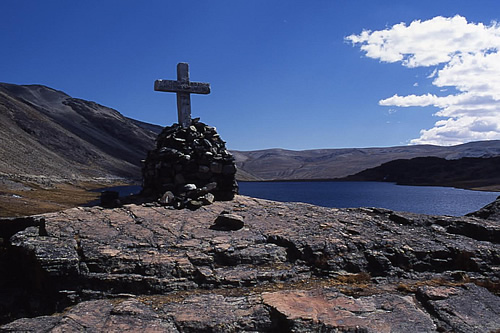 |
| Ruins of the Temple of the Sun at Pisac. |
We climbed through clouds to Machu Picchu, the fabled “lost citadel” that perches incredibly atop a precipitous Andean peak at the edge of dense rainforest. Never discovered by the Conquistadores, the abandonment of this religious, astronomical and architectural glory remains a mystery. We’d all seen it in pictures many times before, but nothing quite prepares you for seeing it in its jaw-dropping mountaintop magnificence.
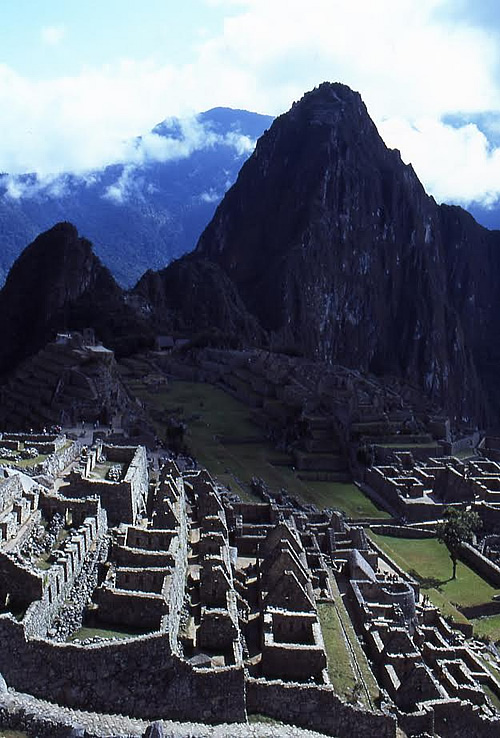 |
| Machu Picchu. |
Leaving the Urubamba valley, we plunged down 2km to the Apurimac River, and slogged up almost as high on the other side to reach the deserted, atmospheric ruins of Choquequirao. Not mentioned in any chronicles, the purpose of this twin-level city bordered by three enormous terraces is unknown. What wasn’t in doubt was that whoever lived at Choquequirao would have enjoyed not only total seclusion, but also some of the finest views over the Apurimac to the confusion of valleys and ravines beyond.
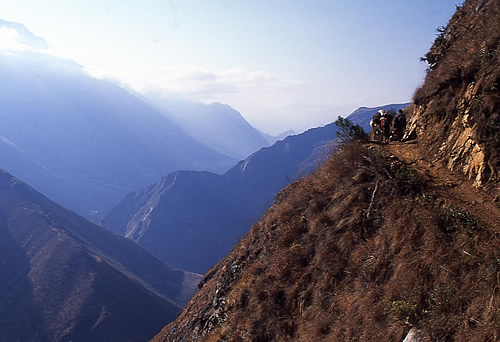 |
| Mountain track through the Apurimac Canyon. |
Traveling deeper into Vilcabamba, we witnessed the great winter solstice festival of Inti Raymi, enacted at the post-Conquest Inca capital of Vitcos. Hacking our way along a thin, winding trail through thick jungle, we eventually reached Espiritu Pampa, the site of Vilcabamba the Old – final stronghold of the Incas. The Incas were no more than a shadow of their imperial greatness by the time they retreated here, but they tried to maintain their customs, religion and grand architecture. Peeking from dense forest beneath a towering canopy of trees, the poignant ruins bear characteristic trapezoidal doorways and niches, but massive trees nowadays overwhelm the crumbling stonework – much as the Conquistadores overwhelmed the Incas.
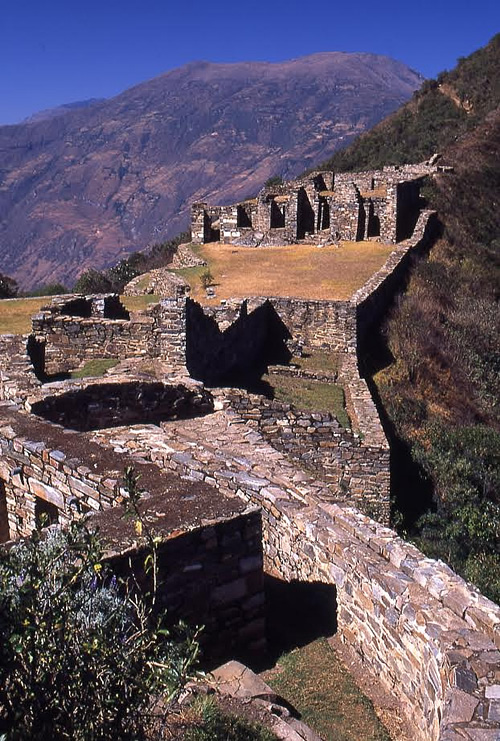 |
| Choquequirao, the “Cradle of Gold.” |
We had reached the history-laden stage where the Incas played out the final scenes of their empire. Nearby, in 1572, the last Inca Tupac Amaru was captured by the Spanish, hauled off to Cuzco, tried and executed, so ending the dazzling, but short-lived, Inca empire.
About Inca Trails
Inca Trails tells the story of an exciting adventure traveling by mule through some of the most remote, rugged and beautiful wilderness in the Bolivian and Peruvian Andes. Our quest through the journey is to trace the rise and fall of the Inca empire from its birthplace in Lake Titicaca, through the remote Apolobamba range of the Andes, to its pinnacle at Cuzco and Machu Picchu, and beyond to the scene of its final stand against the Conquistadores in the densely forested mountains of Vilcabamba. Woven throughout the tale of the journey is the gripping, poignant story of the rise and fall of the glittering, but short-lived, Inca empire.
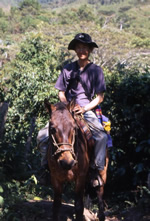 |
Martin Li studied physics at Cambridge. A keen skier, horserider and trekker, he has a passion for exploring the adventure and culture of the world’s great mountain regions, especially the Himalayas, Alps and, above all, the Andean countries of South America. In 2000, he spent four months writing for The Bolivian Times in La Paz, covering diverse subjects ranging from privatization and the Bolivian stock market to cock fighting.
Martin won the 2005 Wilderness Award for this expedition, and has subsequently given several lectures on the journey.
Martin’s other adventures have included riding a horse across the Namib Desert, trekking to Bhutan’s most sacred summit, close encounters with black bears in Alaska and rafting the thundering rapids of Panama’s Rio Chiriqui. Martin is the author of Adventure Guide to Scotland and contributed to V!VA List Latin America. He lives in London and is a Fellow of the Royal Geographical Society. |
|
